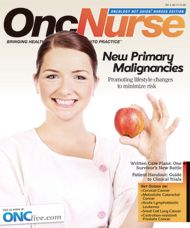Smoking Cessation Products
Getting patients to stop smoking is rarely easy; even patients with smoking-related lung cancer occasionally continue to smoke. In addition to smoking's cancer-causing properties, it has other serious health effects for patients.
Getting patients to stop smoking is rarely easy; even patients with smoking-related lung cancer occasionally continue to smoke. In addition to smoking’s cancer-causing properties, it has other serious health effects for patients. It has been associated with higher rates of occurrence of secondary cancers, poorer treatment response, increased adverse effects, and impaired wound healing. There are several over-the-counter (OTC) and prescription products available to help patients quit.
OTC Nicotine Replacement Therapy (NRT)
NRT products include gum, patches, and lozenges. These provide smokers with a nontobacco source of nicotine to decrease cravings and withdrawal symptoms, which helps them focus on adapting behavioral modifications necessary to quit smoking. Nicotine has been linked to cancer development and progression, and NRT should be discontinued as soon as smoking cessation is achieved. Symptoms of excessive nicotine use include nausea, vomiting, dizziness, diarrhea, weakness,
and rapid heartbeat.
Nicotine polacrilex gum (Nicorette). The gum is a resin complex of nicotine and polacrilin in a sugar-free (contains sorbitol) chewing gum base. It comes in 2- and 4-mg strengths and various flavors. Patients who smoke <25 cigarettes per day should use the 2-mg formulation. In general, nicotine concentration peaks within 30 minutes after chewing, slowly decreasing over the next 2 to 3 hours. Physicians and nurses should instruct patients on proper use of the gum, including the “chew and park” method: after chewing the gum initially, the user should let it sit (or park it) between the gum and cheek to allow the nicotine to be absorbed. Adverse effects include unpleasant taste, dyspepsia, jaw muscle soreness, hypersalivation, hiccups, and mouth irritation. Acidic beverages decrease the gum’s effectiveness. Patients should not eat or drink (except water) for 15 minutes before chewing nicotine gum and while chewing. For weeks 1 through 6, patients should chew 1 piece of NRT gum every 1 to 2 hours while awake, decreasing to 1 piece every 2 to 4 hours for weeks 7 through 9, and tapering off to 1 piece every 4 to 8 hours during weeks 10 through 12. Patients should not use more than 24 pieces per day.
Nicotine polacrilex lozenges.The lozenges consist of a resin complex of nicotine and polacrilin. As with the gum, they come in 2- and 4-mg strengths and several flavors. The 4-mg strength is for people who light up within 30 minutes of waking. Because the lozenge dissolves completely, it delivers ~25% more nicotine than the equivalent dose of nicotine gum. During the first 6 weeks of therapy, patients should use 1 lozenge every 1 to 2 hours while awake, consuming no more than 5 lozenges in 6 hours, and no more than 20 in 24 hours. Recommended dosing intervals and adverse effects/ interactions for lozenges are similar to those of nicotine gum.
Nicotine transdermal system (Nicoderm CQ, Smart Control, Habitrol). These patches continuously release low levels of nicotine over 24 hours. They are available in steps 1 to 3 in strengths of 7, 14, and 21 mg. Patients who smoke >10 cigarettes per day should start with the 21-mg patch and continue for 6 weeks, followed by the 14-mg patch for 2 weeks, and then the 7-mg patch for 2 weeks. Those who smoke <10 cigarettes daily can start with the 14-mg patch for 6 weeks followed by the 7-mg strength for 2 weeks. Local skin irritation, such as pruritus and erythema, is common. Rotating the placement of patches each day can reduce skin irritation. Less common adverse effects include abnormal or vivid dreams, headache, and insomnia.
Prescription Products
Prescription drugs are available for patients who seem to need something stronger, and some might be more appropriate for those in whom nicotine is contraindicated.
Nicotine nasal spray.This is a pump bottle containing nicotine, which smokers inhale when they feel the urge for a cigarette. Nicotine absorption is faster than with OTC products. It is not recommended for people with nasal or sinus conditions, allergies, or asthma. Initial adverse effects include sneezing, coughing, and watering eyes, which resolve with continued use.
Nicotine inhaler.This delivers a vaporized form of nicotine through a mouth piece attached to a plastic cartridge. Much of the nicotine is absorbed by the mucous membranes in the mouth and throat and does not actually reach the lungs. Common adverse effects include mouth irritation and coughing. Patients with bronchial problems such as asthma should use with caution.
Bupropion (Zyban).This prescription antidepressant helps reduce withdrawal symptoms and the urge to smoke and can be used concordantly with NRT. Common adverse effects are dry mouth, difficulty sleeping, headache, dizziness, and skin rash. People with seizure disorders or eating disorders or patients taking medications with bupropion hydrochloride should not use this drug. Patients should avoid alcohol while using bupropion.
Varenicline (Chantix).This drug eases withdrawal symptoms and blocks the effects of nicotine should the patient resume smoking. Common adverse effects include nausea, changes in dreaming, constipation, gas, and vomiting. It is contraindicated in patients with kidney problems and pregnant or breastfeeding women.
Nortriptyline and clonidine.These are not FDA-approved to treat nicotine addiction but are often prescribed off-label to help people quit smoking.
